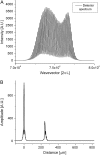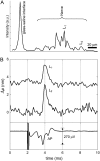Depth-resolved measurement of transient structural changes during action potential propagation
- PMID: 17526590
- PMCID: PMC1929037
- DOI: 10.1529/biophysj.106.091298
Depth-resolved measurement of transient structural changes during action potential propagation
Abstract
We report noncontact optical measurement of fast transient structural changes in the crustacean nerve during action potential propagation without the need for exogenous chemicals or reflection coatings. The technique, spectral domain optical coherence tomography, provides real-time cross-sectional images of the nerve with micron-scale resolution to select a specific region for functional assessment and interferometric phase sensitivity for subnanometer-scale motion detection. Noncontact optical measurements demonstrate nanometer-scale transient movement on a 1-ms timescale associated with action potential propagation in crayfish and lobster nerves.
Figures




Similar articles
-
Optical coherence tomography phase measurement of transient changes in squid giant axons during activity.J Membr Biol. 2009 Sep;231(1):35-46. doi: 10.1007/s00232-009-9202-4. Epub 2009 Oct 6. J Membr Biol. 2009. PMID: 19806385
-
Noncontact measurement of nerve displacement during action potential with a dual-beam low-coherence interferometer.Opt Lett. 2004 Sep 1;29(17):2028-30. doi: 10.1364/ol.29.002028. Opt Lett. 2004. PMID: 15455769
-
Detection of neural activity using phase-sensitive optical low-coherence reflectometry.Opt Express. 2004 May 31;12(11):2377-86. doi: 10.1364/opex.12.002377. Opt Express. 2004. PMID: 19475074
-
Calculation of action potential propagation in nerve fiber.Prog Biophys Mol Biol. 2014 May;114(3):170-4. doi: 10.1016/j.pbiomolbio.2014.03.002. Epub 2014 Mar 22. Prog Biophys Mol Biol. 2014. PMID: 24662745 Review.
-
The use of optical coherence tomography in neurology.Rev Neurol Dis. 2009 Fall;6(4):E105-20. Rev Neurol Dis. 2009. PMID: 20065921 Review.
Cited by
-
Optical coherence tomography phase measurement of transient changes in squid giant axons during activity.J Membr Biol. 2009 Sep;231(1):35-46. doi: 10.1007/s00232-009-9202-4. Epub 2009 Oct 6. J Membr Biol. 2009. PMID: 19806385
-
Detection of Neural Action Potentials Using Optical Coherence Tomography: Intensity and Phase Measurements with and without Dyes.Front Neuroenergetics. 2010 Aug 6;2:22. doi: 10.3389/fnene.2010.00022. eCollection 2010. Front Neuroenergetics. 2010. PMID: 20844600 Free PMC article.
-
Plasmonic imaging of subcellular electromechanical deformation in mammalian cells.J Biomed Opt. 2019 Jun;24(6):1-7. doi: 10.1117/1.JBO.24.6.066007. J Biomed Opt. 2019. PMID: 31222988 Free PMC article.
-
On the Coupling between Mechanical Properties and Electrostatics in Biological Membranes.Membranes (Basel). 2021 Jun 28;11(7):478. doi: 10.3390/membranes11070478. Membranes (Basel). 2021. PMID: 34203412 Free PMC article. Review.
-
Investigation of depth-resolved nanoscale structural changes in regulated cell proliferation and chromatin decondensation.Biomed Opt Express. 2013 Apr 1;4(4):596-613. doi: 10.1364/BOE.4.000596. Epub 2013 Mar 22. Biomed Opt Express. 2013. PMID: 23577294 Free PMC article.
References
-
- Cohen, L. B. 1973. Changes in neuron structure during action potential propagation and synaptic transmission. Physiol. Rev. 53:373–418. - PubMed
-
- Cohen, L. B., R. D. Keynes, and B. Hille. 1968. Light scattering and birefringence changes during nerve activity. Nature. 218:438–441. - PubMed
-
- von Muralt, A. 1975. The optical spike. Philos. Trans. R. Soc. Lond. B Biol. Sci. B270:411–423. - PubMed
Publication types
MeSH terms
Grants and funding
LinkOut - more resources
Full Text Sources
Other Literature Sources

